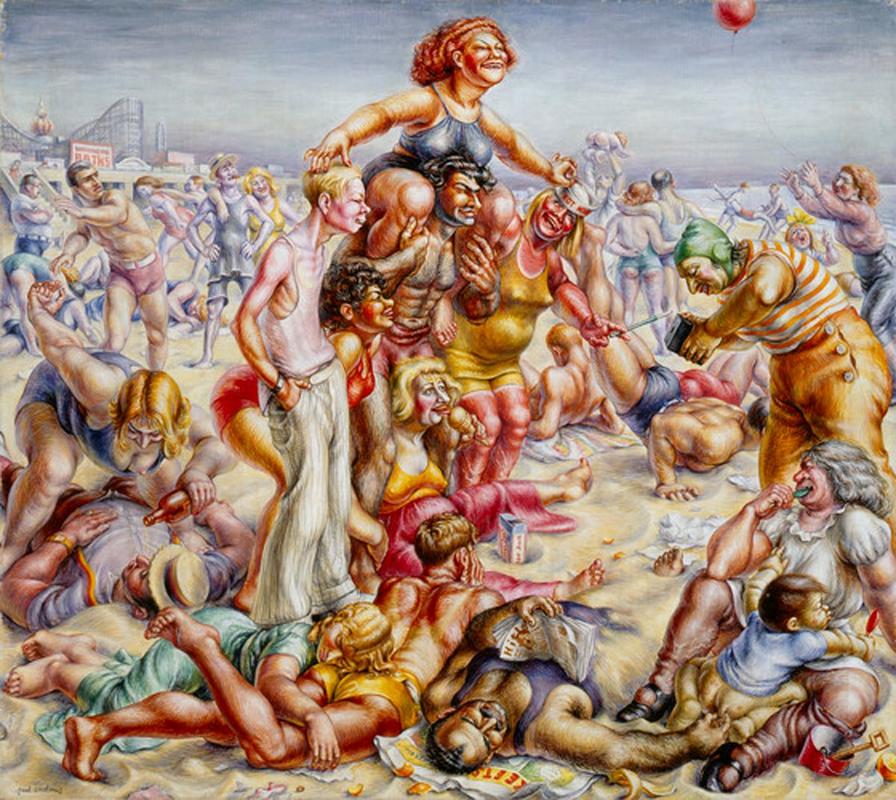More about Coney Island

Sr. Editor
Coney Island reveals a scene of American beach vacationers in a sensual, gluttonous, raucous, and sometimes hideous tableaux.
In this 1930s painting, Paul Cadmus satirizes the summer getaway, showcasing a Coney Island that lives up to its nickname "Sodom by the Sea." As journalist Ken Johnson describes: "It is a microcosm of American popular culture in all its ersatz glory, the anti-Disneyland, a realm of tawdry spectacle and mindless distraction catering to the basic instincts of hoi polloi." For that, Coney Island has long occupied a spot in the American imagination, and the campy seaside playground has been inspiring artists for decades: Joseph Stella, Reneke Dijkstra, Reginald Marsh, Diane Arbus, Walker Evans, Red Grooms, and Jean-Michel Basquiat, to name just a few.
As Dr. Robin Jaffee Frank, curator of the exhibition "Coney Island: Visions of an American Dreamland, 1861-2008" at the Wadsworth Atheneum writes, "The modern American mass-culture industry was born at Coney Island, and the constant novelty of the resort made it a seductively liberating subject for artists. What these artists saw from 1861 to 2008 at Coney Island, and the varied ways in which they chose to portray it, mirrored the aspirations and disappointments of the era and the country. Taken together, these tableaux of wonder and menace, hope and despair, dreams and nightmares become metaphors for the collective soul of a nation.” What, then, can Cadmus' fever dream tableaux tell us about the state America in 1934, the year of its creation?
The revelers Cadmus imagines at Coney Island appear almost grotesque, the caricatured figures fighting for prominence in the crowded scene. We've got a drunk woman pouring her beer into the mouth of an unsuspecting dozing man, her breast popping out of her bathing suit, in a strange act of psuedo-breastfeeding. Another woman is passed out on the rear end of a sunburned acquaintance, using his scantily clad butt cheeks as a pillowy facerest. Beside them, a burly man half-buried in the sand looks up from his magazine, which features Hitler's face, to pinch the bare pimpled butt of a nearby child. The colors are garish, and the distorted bodies and faces nightmarish, but, in true Cadmus fashion, the muscles of the men bulge seductively out of their skimpy tight swimwear.
Coney Island as a center for sin would have appealed to the sexually liberated Cadmus, who was both polyamorous and gay. As journalist Jonathan Weinberg points out, the crowd here is filled with "purposely ugly women and mostly beautiful men." The central focus may be the mixed-sex human pyramid at center, but at its feet lies our hunky sunburned friend, who looks past the heterosexual antics to the athletic body of a man doing an elaborate pushup that highlights his muscular back and buttocks. Weinberg goes on to say that, for Cadmus and his friends, "the chance to gaze unabashedly at the body of a stranger was one of the great pleasures of the milieu." Having the freedom to look and be looked at by other men lustfully would have been rare in the 1930s, and so it makes sense Cadmus would mark Coney Island, much in the same way he did the Navy, as a space ripe for homoerotic fantasy.
As you might imagine, Coney Island caused a bit of a scandal with its debut at the second Whitney biennial. Cadmus had already received negative attention for his depiction of debauched naval officers in The Fleet's In! earlier that year, and this painting was similarly ill received. Brooklyn realtors hated the way their neighborhood was portrayed, and the Coney Island Showmen’s League even threatened to sue for libel due to what they saw as an inaccurate and offensive depiction of their precious carnival grounds. It's possible that audiences were also offended by the insinuation that post-war Americans were, at best, engaging in frivolous pleasures and, at worst, reveling in sin, all while fascism rose in Europe, as indicated by Hitler's appearance on the magazine. According to Cadmus, the painting was subsequently rejected from several shows. Of course, controversy breeds fascination, and Cadmus' work continued to gain popularity.
Sources
- "Coney Island" LACMA https://collections.lacma.org/node/232772
- Dunne, Carey. “Dreamland as Muse: A Look Back at 150 Years of Coney Island Art, Photography, and Film." Brooklyn Magazine, August 17, 2015 https://www.bkmag.com/2015/08/17/dreamland-as-muse-a-look-back-at-150-y…
- Hardman, Ray, “Wadsworth explores Coney Island, the ‘Microcosm of the American experience,” WNPR, February 12, 2015. Date accessed May 20, 2020. https://www.wnpr.org/post/wadsworth-explores-coney-island-microcosm-ame…
- Johnson, Ken. "Amusement for Everyone." New York Times, November 15, 2015 https://www.thewadsworth.org/wp-content/uploads/2015/11/2015_15_15_NYT_…
- Weinberg, Jonathan. "Coney Island Forever," Art in America, September 30, 2015 https://www.artnews.com/art-in-america/features/coney-island-forever-63…











